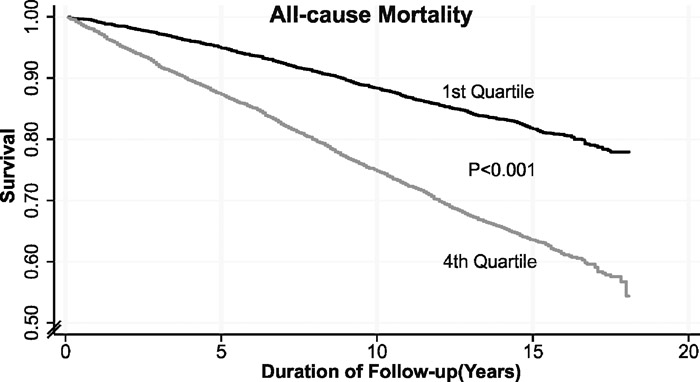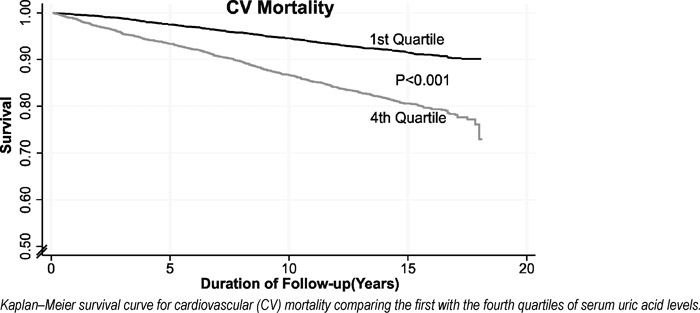Background:
Increased serum uric acid levels are linked to cardiovascular (CV) risk factors, such as obesity, dyslipidemia, and hypertension. Many but not all epidemiological studies have suggested that serum uric acid is a risk factor for CV disease. Therefore, we aimed to examine the association of uric acid with all‐cause and CV mortality in a large cohort of the U.S. population with long‐term follow‐up.
Methods:
We used the Third National Health and Nutrition Examination Survey (NHANES III) to examine associations between serum uric acid levels and all‐cause and CV mortality in individuals > 20 years. Cause‐specific mortality status of participants was obtained by matching to the National Death Index with follow‐up through December 31, 2006. We used a Cox proportional hazards model to calculate univariate and multivariable hazard ratios (HRs) and 95% confidence intervals (CIs) using Sata (version 10.1 for Windows) and taking into account the complex probability sampling survey design.
Results:
Among the 15,499 eligible participants, there were 4124 all‐cause and 1850 CV deaths during the median follow‐up of 14.1 years. The mean (SD) age of the participants was 49 (19) years, 53% were female, 25% were active smokers at baseline, 11% were diabetic, 36% were hypertensive, and 7% had a history of CV disease. Serum uric acid level was significantly higher in participants who died during follow‐up than those who were alive (all‐cause, 5.8 vs. 5.2 mg/dL; P < 0.001; CV, 5.9 vs. 5.3 mg/dL; P < 0.001; Figs. 1 and 2). In unadjusted analysis, serum uric acid levels were significantly associated with all‐cause and CV mortality (HR, 1.14; 95% CI, 1.12–1.16; HR, 1.17; 95% CI, 1.13–1.22, respectively). Uric acid remained significantly associated with all‐cause and CV mortality after adjustment for age, sex, race, diabetes, hypertension, smoking status, glomerular filtration rate, LDL cholesterol, and history of CV disease (HR, 1.08; 95% CI, 1.06–1.10; and HR, 1.07; 95% CI, 1.04–1.11, respectively). In adjusted analysis, subjects with serum uric acid levels in the fourth quartile were at 28% higher risk of all‐cause mortality and 21% higher risk of CV mortality than subjects in the first quartile (HR, 1.28; 95% CI, 1.15–1.42; and HR, 1.21; 95% CI, 1.04–1.40, respectively).
Conclusions:
Elevated serum uric acid levels are independently and significantly associated with increased risk of all‐cause and CV mortality. The mechanisms of this association need further study.
Kaplan–Meier survival curve for all‐cause mortality comparing first with the fourth quartiles of serum uric acid levels.


